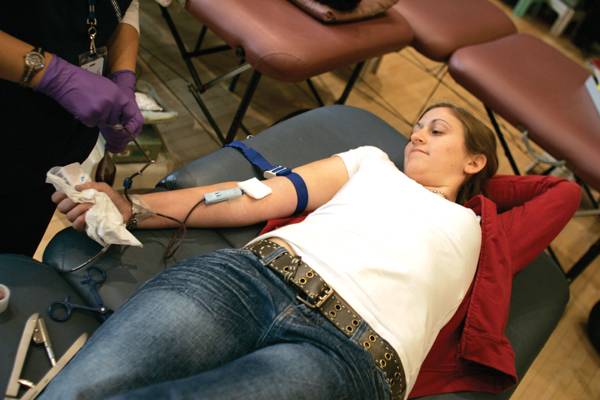REED: How to save a life

Sam O’Flaherty, junior in aerospace engineering, gives blood during the Fall ISU Blood Drive in the Durham Great Hall of the Memorial Union on Oct. 2, 2008. One pint of blood can save up to three lives. Photo: Kevin Zenz/Iowa State Daily.
February 11, 2009
Many of you may have heard about donating plasma and giving blood, as well as the differences between the two.
The main difference is the $65 stipend you get when you donate plasma twice a week, whereas when you give blood, you receive a friendly smile followed by a polite “thank you, we look forward to seeing you again.” With donating blood, there are also those pestering phone calls from your local blood center asking you to donate due to the shortage of your blood type.
What determines one’s choice of donating either blood or plasma? The money? The lives they’ll be saving? Or simply doing it to volunteer in the community?
When you donate plasma, you are hooked up to a machine that takes out your blood and separates the plasma from your blood. After so much is taken out, the machine stops and your blood is then put back into your body while the plasma is filtered into a bag. This cycle continues for an hour to an hour and a half until you have a certain amount of plasma in your bag. The amount of plasma you donate is in correlation with your weight, so not everyone donates the same amount. Once you are shot up with 500 milliliters of saline, you’re on your way. Finally, $20 goes in your pocket if it’s your first time donating in a week, or $45 if it’s your second time in a week.
“The money, more than anything, is the reason I donate, but I do know that it goes toward a good cause and people in need,” says Jason Hofmeyer, a senior in kinesiology and health fitness management. “It’s also great to have a plasma center in a highly populated area and college town so they can get a large amount of plasma.”
Donating blood is a little different, and takes a lot less time. If you are donating a single unit of blood, it will take you around 20-30 minutes for the blood to be taken out of your body and put into a constant moving bag. Once a pint of blood is in the bag, you’re done for eight weeks.
So which is better?
The bottom line is that blood is in much higher demand than plasma. According to the American Red Cross, someone needs blood every minute of every day. Whether that is through a blood transfusion or a platelet transfusion, all eight types of blood are in dire need.
There are just not enough volunteers to give blood. Only three out of every 100 people in the U.S. donate blood, and for every pint of blood given, up to three lives can be saved. “I know that someone will use my blood and they will be grateful for the rest of their life,” Allison Bailey, a junior in biology, said.
Plasma, on the other hand, is used in a variety of ways. It’s manufactured into products that are used to help treat and prevent diseases such as hepatitis B and measles. Plasma itself is used to treat immune system deficiencies and hemophilia.
The thing is, however, plasma isn’t in terrible need.
So much plasma is coming in that the centers don’t need to make phone calls, send e-mails or mail out personal letters to get donors. The compensation plasma donors receive is enough to make them come back week after week. The time spent hooked up to the plasma separator is the reason plasma donors receive the money in the first place.
According to Biolife Plasma Services, the money is given for the donor’s commitment to the program of saving lives. You’re going to “save a life” no matter which route you take; it’s just a matter of whether you want to get paid for being a hero.
So pick your poison, but re-evaluate your reasons to donate and the impact you will have on someone’s life the next time you schedule an appointment.
— Emma Reed is a junior in journalism and mass communication from Alberton, Mt.
















